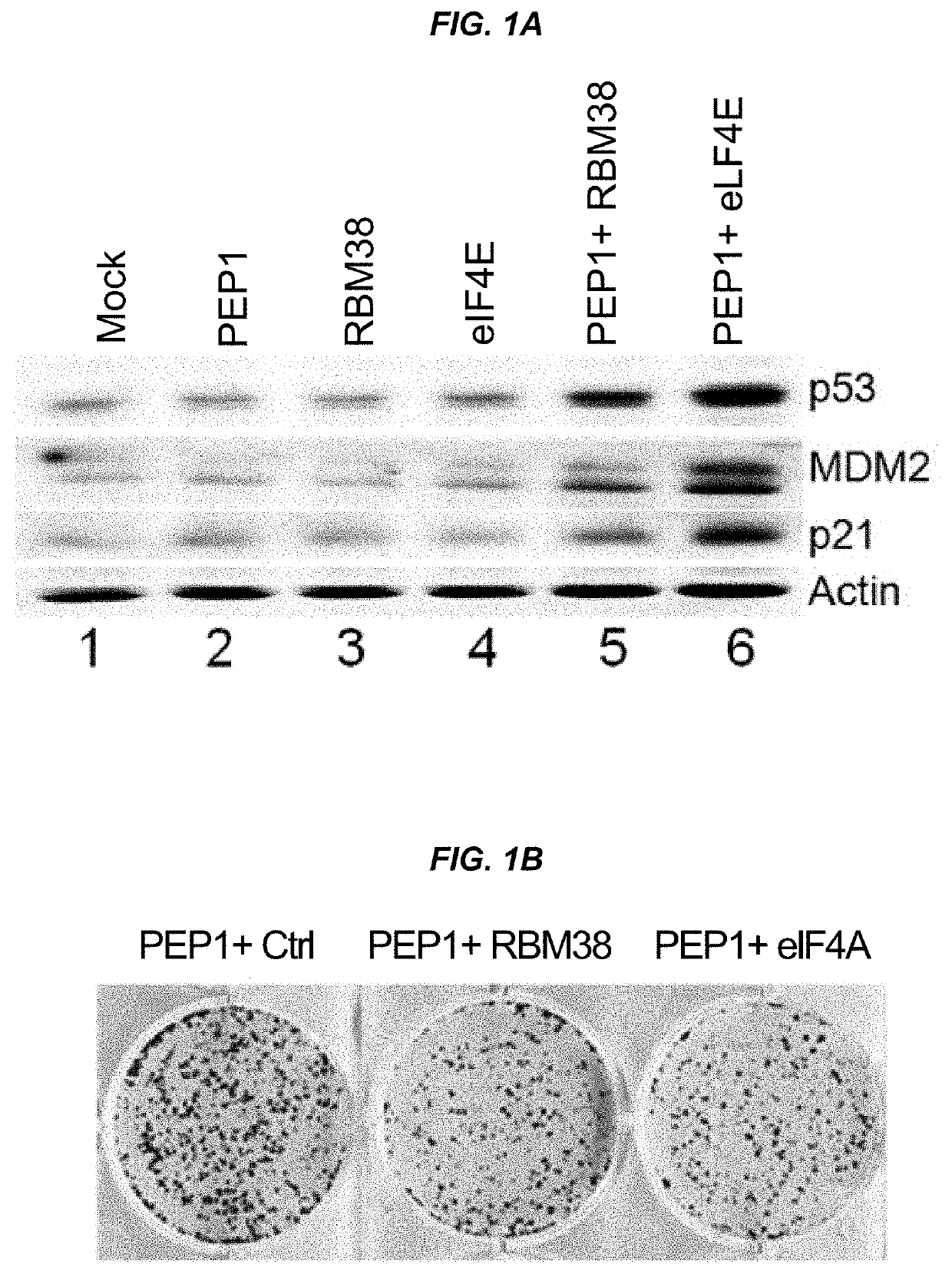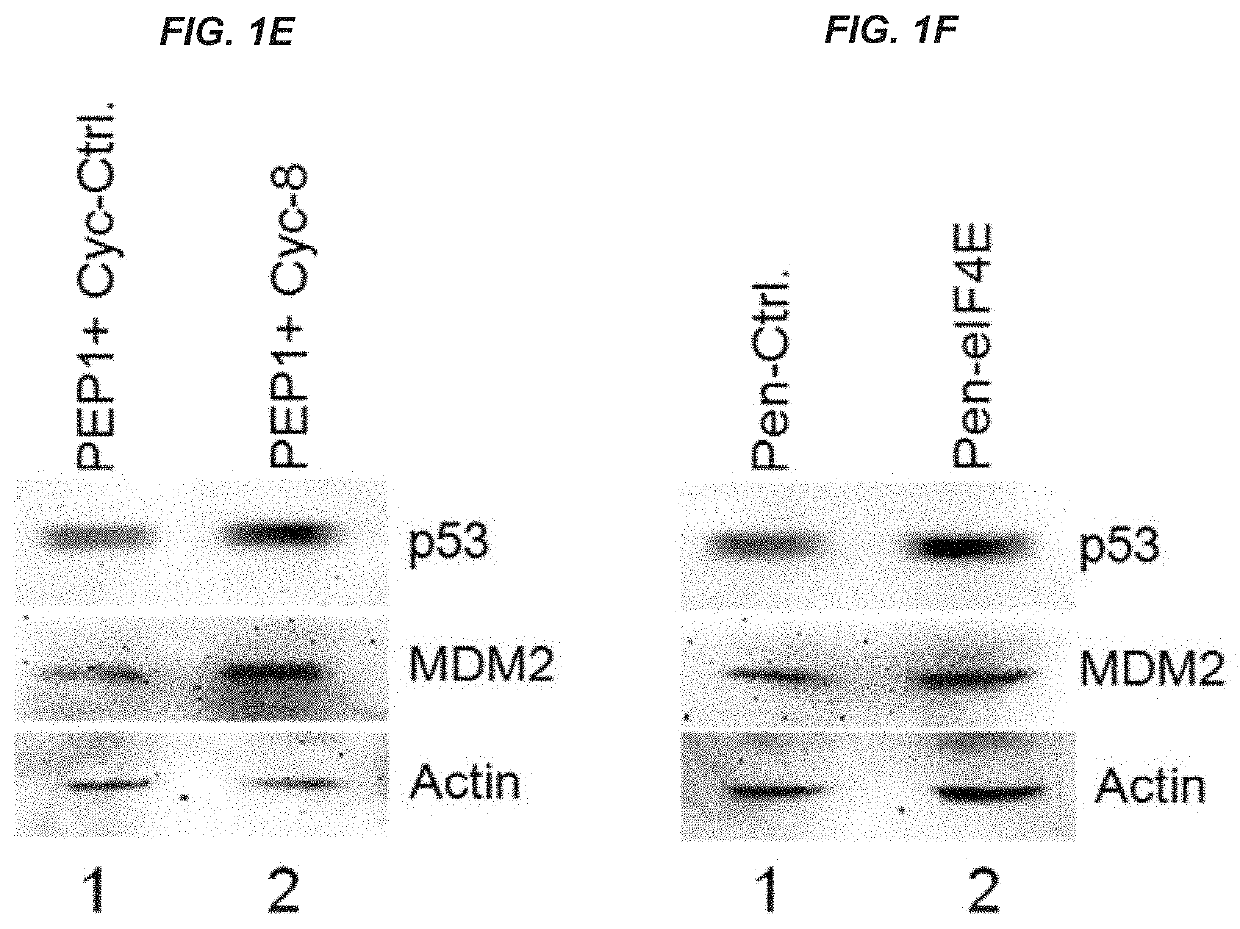Modulation of P53 for the treatment of cancer
a cancer and p53 technology, applied in the field of p53 modulation for cancer treatment, can solve the problems of profound and often dangerous side effects, large public health problems, and large public health problems
- Summary
- Abstract
- Description
- Claims
- Application Information
AI Technical Summary
Benefits of technology
Problems solved by technology
Method used
Image
Examples
example 1
of p53 and Downstream Targets
[0209]This example shows that peptides and oligonucleotides of the present invention were able to induce p53 and downstream targets, as well as inhibit colony formation by cancer cells.
Introduction
[0210]The p53 tumor suppressor plays a pivotal role in maintaining genome integrity, and inactivation of the p53 pathway is found in more than 50% of human cancers. Based on the discovery that the RNA-binding protein RBM38, also called RNPC1, is a target of the p53 family and that RBM38 can in turn repress p53 translation via interacting with eIF4E, peptides and oligonucleotides were designed that disrupt interactions between RBM38 and eIF4E, thus improving p53 translation and protein expression. As shown herein, peptides and oligonucleotides of the present invention successfully enhanced p53 activity, including induction of downstream p53 targets, and inhibited the growth of cancer cells.
Methods
Peptides for p53 Expression Enhancement and Cancer Cell Inhibition...
example 2
Peptides and Oligonucleotides and Demonstration of Effectiveness
[0218]This example describes the design of peptides and oligonucleotides of the present invention and demonstrates their usefulness in increasing p53 expression and inhibition of cancer cell growth.
Small Peptides to Block the Interaction Between RBM38 and eIF4E
[0219]One approach to stabilizing translation and inducing expression of p53 and downstream targets is to design small peptides that block RBM38 inhibition of p53 translation (FIG. 9). In particular, peptides that disrupt the interaction between RBM38 and eIF4E can allow eIF4E to interact with p53 mRNA, permitting translation of p53 to occur.
[0220]Schematic representations of RBM38 and eIF4E are shown in FIGS. 10A and 10B, respectively. The binding interface between these two proteins was mapped to amino acids 180-220 of RBM38 (FIG. 11A) and amino acids 195-217 of eIF4E (FIG. 11B). The sequences of the binding interfaces were determined to be SEQ ID NO:2 for RBM38...
example 3
n of p53 Expression and eIF4E Phosphorylation
[0230]This example demonstrates that compositions and methods of the present invention inhibit phosphorylation of eIF4E, increase expression of p53 and downstream targets, and inhibit tumor cell growth. Furthermore, this example demonstrates that compositions and methods of the present invention exhibit a synergistic effect when combined with other anti-tumor agents.
[0231]As shown in FIG. 31, cell-penetrating peptides (e.g., PEP1) facilitated cellular delivery of peptides of the present invention. RKO or MCF7 cells were grown in 12-well plates with a seed density of 1×105 a day before peptide addition. Peptides were added at a concentration of 6 μM for PEP1 or 300 nM for Pep40 and Pep23. For PEP1+Pep40 / 23, 300 nM Pep40 / 23 was added to 6 μM Pep1 in 100 μL serum-free DMEM for 30 minutes before being added to the cells for 24 hours. After 24 hours, cells were harvested with 1×SDS-lysis buffer (100 μL) and then lysate was run on a 12% SDS-PAG...
PUM
 Login to View More
Login to View More Abstract
Description
Claims
Application Information
 Login to View More
Login to View More - R&D
- Intellectual Property
- Life Sciences
- Materials
- Tech Scout
- Unparalleled Data Quality
- Higher Quality Content
- 60% Fewer Hallucinations
Browse by: Latest US Patents, China's latest patents, Technical Efficacy Thesaurus, Application Domain, Technology Topic, Popular Technical Reports.
© 2025 PatSnap. All rights reserved.Legal|Privacy policy|Modern Slavery Act Transparency Statement|Sitemap|About US| Contact US: help@patsnap.com



